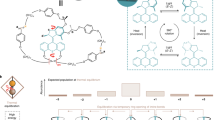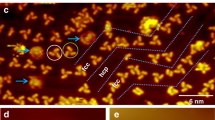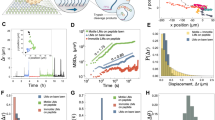Abstract
Molecular machines, and in particular molecular motors with synthetic molecular structures and fuelled by external light, voltage or chemical conversions, have recently been reported1,2,3,4,5,6. Most of these experiments are carried out in solution with a large ensemble of molecules and without access to one molecule at a time, a key point for future use of single molecular machines with an atomic scale precision. Therefore, to experiment on a single molecule-machine, this molecule has to be adsorbed on a surface, imaged and manipulated with the tip of a scanning tunnelling microscope (STM)7,8,9,10. A few experiments of this type have described molecular mechanisms in which a rotational movement of a single molecule is involved. However, until now, only uncontrolled rotations11,12,13 or indirect signatures14,15 of a rotation have been reported. In this work, we present a molecular rack-and-pinion device for which an STM tip drives a single pinion molecule at low temperature. The pinion is a 1.8-nm-diameter molecule functioning as a six-toothed wheel interlocked at the edge of a self-assembled molecular island acting as a rack. We monitor the rotation of the pinion molecule tooth by tooth along the rack by a chemical tag attached to one of its cogs.
This is a preview of subscription content, access via your institution
Access options
Subscribe to this journal
Receive 12 print issues and online access
$259.00 per year
only $21.58 per issue
Buy this article
- Purchase on Springer Link
- Instant access to full article PDF
Prices may be subject to local taxes which are calculated during checkout




Similar content being viewed by others
References
Fletcher, S. P., Dumur, F., Pollard, M. M. & Feringa, B. L. A reversible, unidirectional molecular rotary motor driven by chemical energy. Science 310, 80–82 (2006).
Pijper, D., van Delden, R. A., Meetsma, A. & Feringa, B. L. Acceleration of a nanomotor: Electronic control of the rotary speed of a light-driven molecular rotor. J. Am. Chem. Soc. 127, 17612–17613 (2005).
Chatterjee, M. N., Kay, E. R. & Leigh, D. A. Beyond switches: Ratcheting a particle energetically uphill with a compartmentalized molecular machine. J. Am. Chem. Soc. 128, 4058–4073 (2006).
Van Delden, R. A., Koumura, N., Schoevaars, A., Meetsma, A. & Feringa, B. L. A donor–acceptor substituted molecular motor: Unidirectional rotation driven by visible light. Org. Biomol. Chem. 1, 33–35 (2003).
Hernandez, J. V., Kay, E. R. & Leigh, D. A. A reversible synthetic rotary molecular motor. Science 306, 1532–1537 (2004).
Van Delden, R. A. et al. Unidirectional molecular motor on a gold surface. Nature 437, 1337–1340 (2005).
Eigler, D. M. & Schweizer, E. K. Positioning single atoms with a scanning tunnelling microscope. Nature 344, 524–526 (1990).
Meyer, G. & Rieder, K. H. Controlled manipulation of single atoms and small molecules with the scanning tunnelling microscope. Surf. Sci. 377, 1087–1093 (1997).
Jung, T. A., Schlittler, R. R., Gimzewski, J. K., Tang, H. & Joachim, C. Controlled room-temperature positioning of individual molecules: Molecular flexure and motion. Science 271, 181–184 (1996).
Moresco, F. et al. Low temperature manipulation of big molecules in constant height mode. Appl. Phys. Lett. 78, 306–308 (2001).
Shirai, Y., Osgood, A. J., Zhao, Y. M., Kelly, K. F. & Tour, J. M. Directional control in thermally driven single-molecule nanocars. Nano Lett. 5, 2330–2334 (2005).
Shirai, Y. et al. Surface-rolling molecules. J. Am. Chem. Soc. 128, 4854–4864 (2006).
Gimzewski, J. K. et al. Rotation of a single molecule within a supramolecular bearing. Science 281, 531–533 (1998).
Keeling, D. L. et al. Bond breaking coupled with translation in rolling of covalently bound molecules. Phys. Rev. Lett. 94, 146104 (2005).
Vaughan, O. P. H., Williams, F. J., Bampos, N. & Lambert, R. M. A chemical switchable molecular pinwheel. Ang. Chem. Int. Edn 45, 3779–3781 (2006).
Gross, L. et al. Tailoring molecular self-organization by chemical synthesis: Hexaphenylbenzene, hexa-peri-hexabenzocoronene, and derivatives on Cu(111). Phys. Rev. B 71, 165428 (2005).
Meyer, G. A simple low-temperature ultrahigh-vacuum scanning tunnelling microscope capable of atomic manipulation. Rev. Sci. Instrum. 67, 2960–2965 (1996).
Sautet, P. & Joachim, C. Calculation of benzene on rhodium STM images. Chem. Phys. Lett. 185, 23–27 (1991).
Acknowledgements
We gratefully acknowledge partial funding by the Volkswagen Foundation Project ‘Single molecule synthesis’ and the European Projects NANOMAN and AMMIST.
Author information
Authors and Affiliations
Contributions
F.C., L.G. and F.M. were responsible for the experimental STM work, A.G. and C.J. for the molecular design and A.G. for the chemical synthesis; S.S. and C.J. were in charge of the theory and of the STM image calculation and interpretation and K.H.R. was responsible for the planning of the experiments.
Corresponding author
Ethics declarations
Competing interests
The authors declare no competing financial interests.
Rights and permissions
About this article
Cite this article
Chiaravalloti, F., Gross, L., Rieder, KH. et al. A rack-and-pinion device at the molecular scale. Nature Mater 6, 30–33 (2007). https://doi.org/10.1038/nmat1802
Received:
Accepted:
Published:
Issue Date:
DOI: https://doi.org/10.1038/nmat1802
This article is cited by
-
How to control single-molecule rotation
Nature Communications (2019)



